Asus ROG Spatha Review
Asus ROG Spatha
This is madness. This is Spatha.
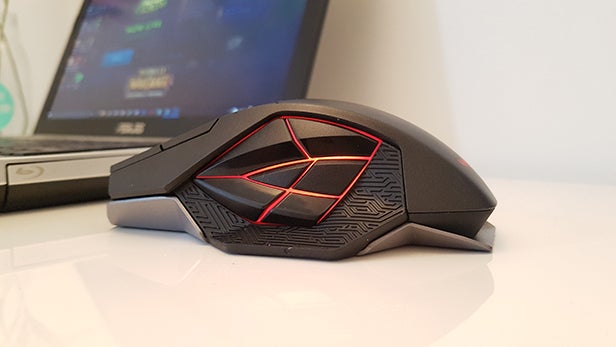
Verdict
Pros
- Looks great
- Comfortable in hand
- Lots of features
Cons
- Enormous and heavy
- Awkward charging plate
- Stiff buttons
Key Specifications
- Review Price: £144.95
- Wired and wireless
- 8,200 DPI
- 150ips 30g tracking
- 2,000Hz polling (wired)
- 12 reprogrammable buttons
- Omron click switches with customisable resistance
- Built-in storage
- ROG Armoury software
- RGB lighting
What is the Asus ROG Spatha?
The Asus ROG Spatha is Asus’ flagship gaming mouse, offering both wired and wireless play, and ships under the firm’s Republic of Gamers sub-brand.
Embracing that flagship territory means that the Asus ROG Spatha also carries a lofty price tag of £145. It’s a hefty mouse that offers customisability and top-end performance, so serious gamers will want to consider it.
But the gaming mouse market is heavily saturated, and Asus is going up against formidable opponents such as Razer and Logitech – two brands that pour their heart and soul into the peripheral business. Can a computing brand really compete? And, more importantly, can Asus justify the Spatha’s wallet-pillaging price? I’m not convinced.
Related: Best Gaming Keyboards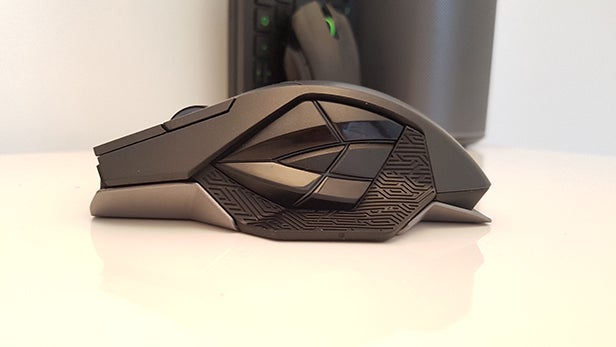
Asus ROG Spatha – Design and Ergonomics
The Asus ROG Spatha is enormous. Its mat-spanning chassis reminds me of the Roccat Nyth, an equally cumbersome unit that looks like it was designed for a yeti. I use my girlfriend as a litmus test for sizing up mice, because she has tiny hobbit hands. After a quick play, her verdict was that the Asus ROG Spatha is so big it’s awkward. Sorry, Asus – you won’t flog many of these in the Shire.
Not surprisingly, the Asus ROG Spatha is also quite heavy, weighing in at 179g. That’s far more than its biggest wireless rivals, the Razer Mamba (125g) and the Logitech G900 (107g). In my opinion, the Spatha is simply too heavy to use comfortably.
Despite its smooth, magnesium base, the Spatha feels like a chore to lug across even the most forgiving surfaces. There’s no reason why the Spatha should be so heavy when rival devices have managed to keep the weight down.
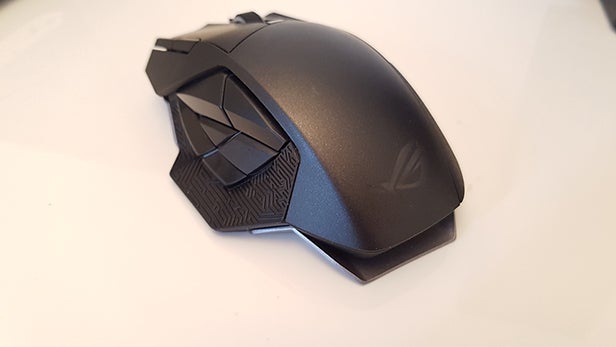
On the bright side, the Asus ROG Spatha has a very grippy surface, which makes it easy to hold. It also has an angular body, with plenty of nooks into which you can squeeze your digits. These jagged edges give it a fearsome appearance, so top marks for desk appeal.
The combination of the large, long body and angular form mean that you really only have one choice of grip, and that’s palm grip. I tried using claw, and it just doesn’t work.
Related: Best Gaming PC
The Asus ROG Spatha has buttons aplenty: 12 reprogrammable keys adorn the mammoth chassis, including six hotkeys on the side and a two-level DPI switcher on the top.
For gamers, the most interesting keys are those on the left side of the mouse. You’ll want to map these for various commands, which is a must for MMO gamers.
They’re laid out in the shape of the ROG eye logo, meaning they’re different shapes. This is the ultimate double-edged sword. On the one hand, the variety of shapes make it reasonably easy to discern which button is which. On the other, it means that some of the buttons are hard to hit, because they’re too small or in a weird place.
The two worst offenders are the bottom-centre and middle-centre keys. Worse still, all six buttons are sticky and tough to press, which is annoying when you’re trying to play fast-paced games.
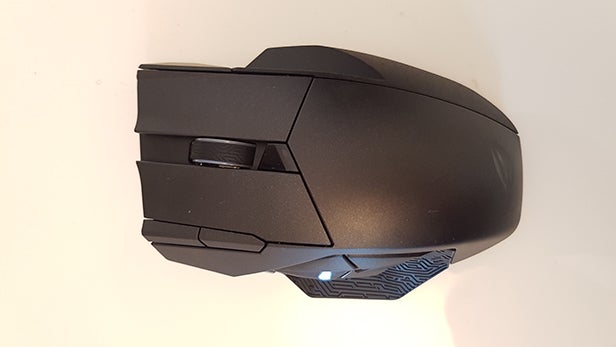
The only other point worth noting is that Asus supplies the Spatha with two cables: a 1m cable and a 2m cable. You also have the option of wireless play, but more on that later.
Overall, I have mixed feelings about the ergonomics of the Asus ROG Spatha. It looks impressive on my desk, and feels comfortable in the hand. But a cumbersome body, awkward button design, and a lack of support for anything other than palm-grip means it has a more limited audience than it should.
Asus ROG Spatha – Features
In this price range you’d expect an abundance of bonus features, and the Asus ROG Spatha doesn’t disappoint. There are extras aplenty, starting with lighting.
Like nearly all gaming mice, the Asus ROG Spatha comes equipped with an RGB lighting system. There are three independent lighting zones – ROG logo, scroll wheel, and side buttons – all of which can be linked as a trio. Using the bundled Asus software, you can set these zones to any one of 16 million colours. There are also six different lighting modes: Static, Trigger, Cycling, Breathing, Random, and Battery. The latter changes the colour depending on battery life.
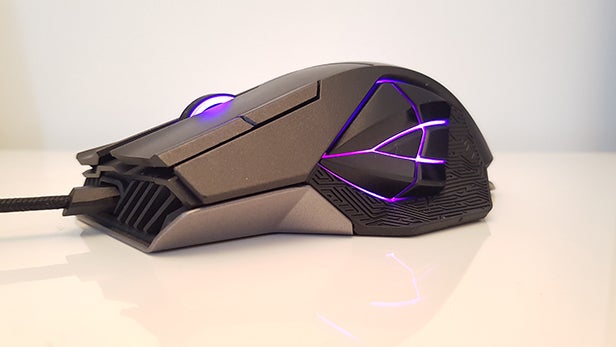
One of the Spatha’s more unique features is customisable click resistance. The Spatha’s right- and left-click buttons use Omron switches. The ones supplied inside the mouse are 60gf (gram force), light-touch switches that are rated for 20 million clicks.
But Asus also supplies a second pair that have a heavier 75gf actuation, making them a lot tougher to press. They’re rated for only one million clicks, so you may need to replace them eventually, but they’re arguably the better choice for more controlled, non-twitchy gameplay.
To help you swap out the switches, Asus supplies a star-tip screwdriver. You’ll need to take off the four rubber pads, and then remove four screws. A magnetic tip screwdriver would have been useful, since the screws stop twisting about half a centimetre before leaving the chassis. Even tipping the mouse upside down wasn’t enough to jerk them out.
Once the screws are out, the top lifts off and you can take out the switches. The right switch comes out easily, but the left switch sits halfway beneath the side of the chassis, which makes it a real pain to work out. Regardless, the entire switch-swapping process took about four minutes the first time I tried it. With practice, I got this down to about a minute-and-a-half.
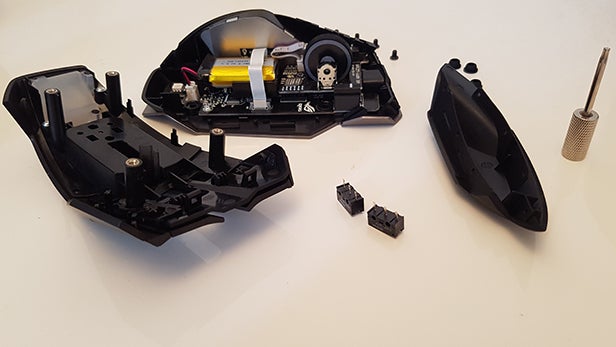
Unfortunately, I’m not actually convinced any of this is particularly useful. The light switches are, in my opinion, already too tough; the Logitech G900 has far more pleasant actuation. It’s partly an issue with the long buttons, but also because the switches are placed too far up the chassis. Besides, the click isn’t particularly pleasant, so having even heavier switches bundled seems a little backwards.
The third feature is a charging platform, which is a neat idea – Razer offers a similar solution with the Mamba. I’m fond of charging platforms, and the Asus one looks cool. It features an LED battery indicator, and a kickstand that lets you switch it from flat to upright, depending on your tastes.
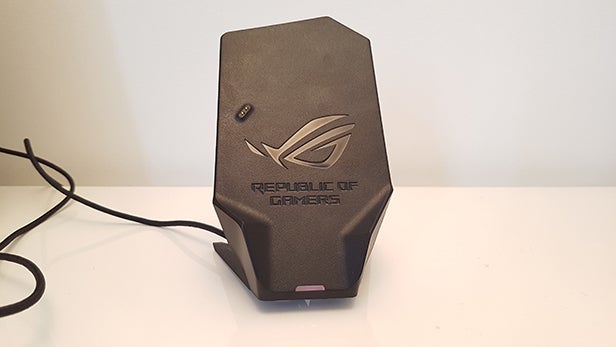
The platform is magnetic, so the mouse sticks to it really well and there’s no risk of you missing the charging pins. But the magnets are incredibly strong, mainly because they have to support the mouse when it’s upright.
Unfortunately, the stand isn’t weighted enough, which means that when you try to pull the mouse away, it isn’t a clean detachment. About 70% of the time, you’ll end up dragging the platform around the mouse trying to prise it off, until you’re forced to use your second hand to pull it free. It’s frustrating.
The final feature is simple, but effective: the humble carry case. The case lets you cart about all of the finnicky Spatha accessories: the cables, the charging platform, the spare switches, and the screwdriver, for instance. If you frequent LAN parties at friends’ houses then you’ll get good use out of the case.
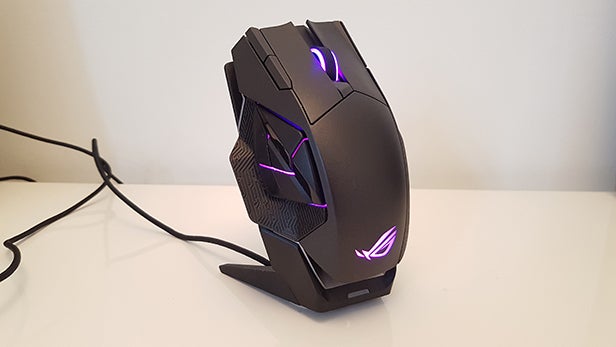
Asus ROG Spatha – Software
Like its major rivals, Asus offers its own custom-built software: ROG Armoury. It’s Windows-only, and you’ll need to be running at least Windows 7, right the way up to Windows 10.
In 2016, most manufacturers have managed to crack gaming mouse software. Asus is no exception; ROG Armoury is well-equipped and offers just about all the major features you’d ever need. We’re talking surface calibration, lighting customisation, button re-mapping, hotkey macros, and so on.
Related: Best PC Games 2016
You can also create up to five profiles, each with different settings. You can switch between these on the fly through key commands. Better still, the profiles are stored on the Spatha’s built-in flash memory, so you can take your profiles with you on the go.
There’s little to discuss when it comes to the Asus software. It’s very good, and on a par with rival systems. Top marks.
Asus ROG Spatha – Performance
While the Asus ROG Spatha has a few issues with its ergonomics, performance is great.
First, it’s important to remember that the Spatha is a wireless mouse. That means it will perform differently when it’s in wired mode. Asus doesn’t give exact latency numbers, but you can expect several milliseconds of delay when using the Spatha in wireless mode, depending on the room conditions and where you place the receiver.
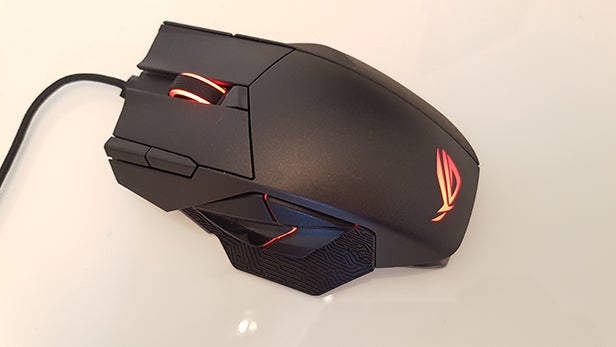
You’ll also be forced to drop the polling rate in wireless mode. Polling rate is the number of times per second that the mouse reports its location to the computer, and it’s measured in Hertz (Hz). Asus managed an impressively high 2,000Hz polling rate in wired mode, which is offered by very few gaming mice.
In fact, it’s probably more than is necessary for most users, since 500Hz is generally considered to be enough for accurate reporting. It’s also worth remembering that having a higher polling rate puts a greater load on your computer’s processor, so you might want to dial down the Spatha’s 2,000Hz a notch if you have a less powerful machine. When in wireless mode, you’ll get 1,000Hz polling – which is also very impressive, and far more practical than 2,000Hz.
The Spatha comes equipped with a respectable sensor that can track up to 30g hand acceleration, and speeds of up to 150-inches-per-second. However, that’s trumped by the rival Logitech G900, which offers 40G acceleration and 300-inches-per-second tracking. Still, the Spatha’s tracking is sufficient for high-end gaming, so don’t let this put you off.
I found the Spatha’s sensor to be largely reliable on a range of surfaces, although there was some noticeable cursor jittering in wireless mode. I’m still not sure if that’s a problem with the sensor, or if the antenna is just in a bad position. Nevertheless, I found the Logitech G900 to have more consistent tracking.
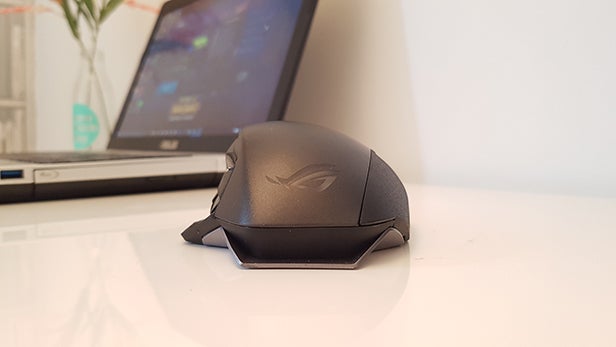
With the Spatha, you’re looking at a fairly lofty 8,200dpi. For the unaware, dots per inch is a measure of how sensitive a mouse is. The higher the DPI, the farther your cursor will move in relation to the mouse’s travel. So a high DPI means you’ll get very fast cursor movements on-screen. At 8,200dpi you’ll struggle to control the mouse, unless you’re either very well practised or using a very high-resolution monitor.
Most gamers will settle somewhere between 1,000 and 3,000dpi, but it’s good to have the added flexibility of an 8,200 maximum. After all, if you have four 4K monitors linked together, you’ll want a high DPI.
The final note is on battery life. I had no issue keeping the Spatha alive, and that’s thanks to the dock. It’s easy enough to replace the Spatha on the dock when out of use, so I never managed to run it dry. I managed up to six-hour sessions without killing off the Spatha, so I wouldn’t worry unless you’re going really hard for extended periods of time in wireless mode.
Asos ROG Spatha – Gaming
The Asus ROG Spatha is a bulky, cumbersome mouse with plenty of buttons. That puts it in a niche that won’t serve all gamers as well as other mice might, depending on your gaming style.
For an MMO, the Spatha is in its element. The bonus buttons are useful for binding ability hotkeys, and the heavy size is less of an issue. It’s still trumped by mega-button offerings such as the Razer Naga, but it remains decent enough. You’ll find similar competency from the Spatha with RPGs and action-adventure titles.
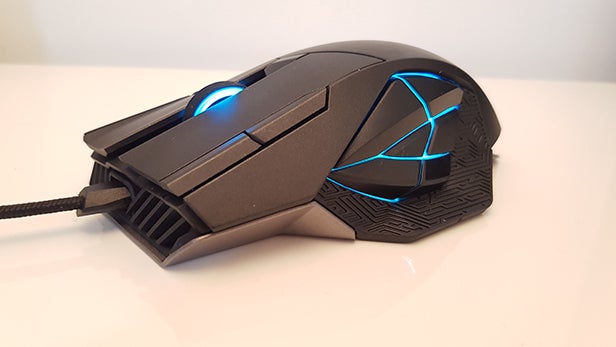
Where the Spatha is less impressive is with twitch gameplay. You want light, accurate mice for shooters and MOBAs, so the heavy Spatha isn’t ideal.
What’s more, all the faff and added buttons just complicate matters. In a shooter, you just want to click and kill at lightning speed, so more trimmed-down options such as the Razer Mamba and Logitech G900 will serve you better.
Related: Best Gaming Mouse 2016
Should I buy the Asus ROG Spatha?
There’s plenty that I love about the Asus ROG Spatha. It’s comfortable – like a big old recliner that you could sit in for hours. It looks cool, and the side-lighting is appropriately fierce. Plus there’s plenty to play with in terms of hardware and software if you’re a tinkerer.
But the Asus ROG Spatha has some serious flaws. It’s too heavy and bulky to suit all types of gameplay. Some aspects of design need refining, such as the sticky and awkward-to-locate side buttons, and the switch-swapping system. And the charging platform can often be more of a hindrance than a help.
It would also be worth considering whether or not you want a wireless model. If you’re not bothered about wireless play then you shouldn’t pay the £145 Asus is asking for. There are far cheaper wired alternatives, such as the Razer Mamba Tournament Edition, that are excellent.
If you’re set on a wireless mouse then the question is whether it’s better than the Razer Mamba (2015) and the Logitech G900 Chaos Spectrum. In both cases, I’d say no. The Razer and Logitech offerings are more consistent, more attractive, more ergonomic, and more versatile. They’re also cheaper: Amazon has the Mamba for £132, while Logitech sells the G900 for £135 (although Currys is doing it for £119.99 right now).
The price of the Asus ROG Spatha puts it at the very top end of the market, which means it simply can’t afford not to be perfect. It’s not perfect.
Verdict
The Asus ROG Spatha sounds great on paper, but clumsy execution leaves it feeling slightly overpriced.


